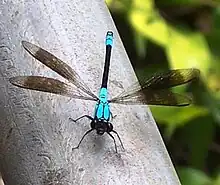| Diphlebiidae | |
|---|---|
 | |
| Tropical rockmaster | |
| Scientific classification | |
| Kingdom: | |
| Phylum: | |
| Class: | |
| Order: | |
| Suborder: | |
| Superfamily: | |
| Family: | Diphlebiidae |
| Genera | |
Diphlebiidae is no longer recognised as a biological family.[1] It was the name given to a small family of damselflies, the azure damselflies, with species in two genera: Diphlebia and Philoganga.[2] Diphlebia is found in Australia[3] and Philoganga is found in Southeast Asia. They are large and thick-bodied damselflies. They rest with their wings spread out. The Diphlebiidae were also known as Philogangidae.
Diphlebiidae is now split:
- The genus Diphlebia is now considered to belong to the family Lestoideidae.[4]
- The genus Philoganga is now considered to belong to the family Philogangidae.[5]
References
Wikimedia Commons has media related to Diphlebiidae.
Wikispecies has information related to Diphlebiidae.
- ↑ Dijkstra, K.D.B.; et al. (2013). "The classification and diversity of dragonflies and damselflies (Odonata). In: Zhang, Z.-Q. (Ed.) Animal Biodiversity: An Outline of Higher-level Classification and Survey of Taxonomic Richness (Addenda 2013)". Zootaxa. 3703 (1): 36–45. doi:10.11646/zootaxa.3703.1.9. hdl:10072/61365.
- ↑
- ↑
- ↑ "Genus Diphlebia Selys, 1869". Australian Faunal Directory. Australian Biological Resources Study. 2012. Retrieved 4 April 2017.
- ↑ Schorr, Martin; Paulson, Dennis. "World Odonata List". Slater Museum of Natural History. University of Puget Sound. Retrieved 4 April 2017.
This article is issued from Wikipedia. The text is licensed under Creative Commons - Attribution - Sharealike. Additional terms may apply for the media files.